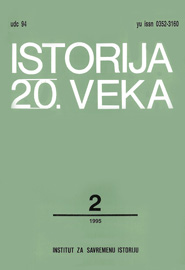SECESIONISTIČKA POBUNA NA KOSOVU I METOHIJI 1944-1945.
THE SECESSIONIST UPRISING IN KOSOVO AND METOHIJA 1944-1945.
Author(s): Đorđe BorozanSubject(s): Geography, Regional studies, Political history, Social history, Recent History (1900 till today), WW II and following years (1940 - 1949), Geopolitics
Published by: Institut za savremenu istoriju, Beograd
Keywords: Yugoslavia; Kosovo and Metohija; secessionist uprising; 1944-1945; British involvement;
Summary/Abstract: The armed uprising in Kosovo and Metohija, first in the region of Uroševac and Gnjilane in December 1944 and then in Drenica and Šalja in January and February 1945, an attempt to separate Kosovo and Metohija from Yugoslavia, was the organized effort of the counter-revolutionary forces of one part of the Albanian population unwilling to accept the eradication of the borders set by the fascist Great Albania. This attempt to annex Kosovo and Metohija to Albania was carried out with the consent of Albanian political circles by a part of the political cadres of Kosmet Albanians and was the consequence of the program proposed by the Central Committee of the Second Leaque of Prizren, founded in Prizren on September 1943. The leaders of the uprising, Šaban Poluža, Mehmed Gradica and Adem Voka, convinced followers of Džafer Deva and Bedri Pejani, took advantage of the slow and hesitant reaction of the Regional Committee of Kosmet and turned the unit which had already been mobilized for the! Srem front to fighting the newly established regime. The interest of British military intelligence forces in maintaining monarchistic regimes in Greece, Albania and Yugoslavia, their direct connection in the Greek civil war in 1944 and the political and propagandist activity of the heads of the British war mission in Albania in 1944 and 1945, undoubtedly point to British involvement in the uprising in Kosovo, Metohija and northern Albania. The secessionist movement, begun in this part of Yugoslavia and connected to events which took place in northern Albania, demonstrates the opposition of a part of the Albanian ethnic population in Yugoslavia against the changing of the »borders« of Great Albania.
Journal: Istorija 20. veka
- Issue Year: 1995
- Issue No: 2
- Page Range: 63-76
- Page Count: 14
- Language: Serbian

